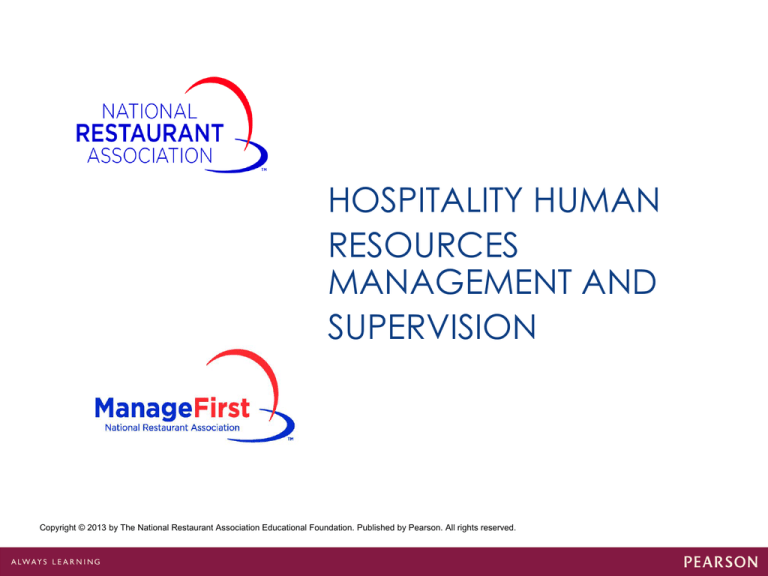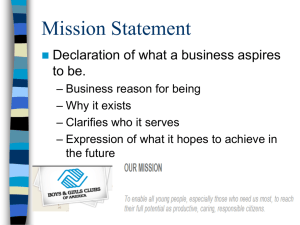
HOSPITALITY HUMAN
RESOURCES
MANAGEMENT AND
SUPERVISION
Copyright © 2013 by The National Restaurant Association Educational Foundation. Published by Pearson. All rights reserved.
Chapter 3
Employee
Orientation
and Training
Copyright © 2013 by The National Restaurant Association Educational Foundation. Published by Pearson. All rights reserved.
Learning Objectives
1. Review basic procedures that should be used
for employment and payroll documentation
2. Explain basic procedures that should be
included in hiring and orientation activities
3. Describe how to plan and evaluate orientation
programs
4. Explain procedures for planning and delivering
training programs
Copyright © 2013 by The National Restaurant Association Educational Foundation. Published by Pearson. All rights reserved.
Employment & Payroll Documentation
• Required
– Form W-4: Employee’s Withholding Allowance
Certificate
– State and local tax forms
– Position related
– Job eligibility:
– Minors: written permission from parent or
guardian; work permit
– Alcohol service: age verification
Copyright © 2013 by The National Restaurant Association Educational Foundation. Published by Pearson. All rights reserved.
Employment & Payroll Documentation
• Benefit Enrollment
– Health, life, other
– Allow employee time to review choices & ask
questions first
– Federal government regulations for pensions, & some
health care programs
• Personnel Files
– See Exhibit 3.2, p. 69: Information to keep in and
separate from a personnel file
– If applicable, termination documentation
– Safe, secure storage
– Protect from fire, theft, damage
Copyright © 2013 by The National Restaurant Association Educational Foundation. Published by Pearson. All rights reserved.
Hiring and Orientation Activities
• Timing: see Exhibit 3.3, p. 71
• Checklists
– New Hire: see Exhibit 3.5, p. 73
– Orientation: see Exhibit 3.6, p. 74
• Planning
–
–
–
–
–
Time frame
Content and structure: What everyone should know
Specific department & position information
Materials
Trainers and other contributors
Copyright © 2013 by The National Restaurant Association Educational Foundation. Published by Pearson. All rights reserved.
Employee Handbook
• To understand job requirements &
establishment’s policies
• Signed form to indicate receipt of
• Exhibit 3.9 p.79: sample table of contents
– Overview
– Employee practices
– Benefits & eligibility
– General
Copyright © 2013 by The National Restaurant Association Educational Foundation. Published by Pearson. All rights reserved.
Evaluating Orientation Programs
• Determine if participants liked program &
felt it was useful
• Know whether participants learned what
was intended
• Were objectives accomplished in a costeffective manner
• One-on-one conversations or form at the
end of the session(Exhibit 3.10, p.80)
Copyright © 2013 by The National Restaurant Association Educational Foundation. Published by Pearson. All rights reserved.
Evaluating Orientation Programs
• Ask the trainer for feedback
• How to make it more effective
• Annual evaluation, information from each
session versus cost to complete
Copyright © 2013 by The National Restaurant Association Educational Foundation. Published by Pearson. All rights reserved.
Employee Training Programs
• An investment not an expense; benefits
greater than cost
• Benefits
–
–
–
–
–
–
Improves quality of work
Promotes employee growth
Keeps employees challenged & satisfied
Creates talent to help organization grow
Job skills improvement
Other
Copyright © 2013 by The National Restaurant Association Educational Foundation. Published by Pearson. All rights reserved.
Principles of Training
• What employee must do to meet job standards
• Those tasks that employees not currently able to
perform
• Should provide as much hands on work as practical
• Elements:
– Content based on job guidelines
– Clearly stated learning objectives
– Qualified & thoroughly prepared trainers
– Sufficient practice
– Effective training evaluation
Copyright © 2013 by The National Restaurant Association Educational Foundation. Published by Pearson. All rights reserved.
Determining Training Needs
• Observing performance-differences from
SOPs
• Input from employees and customers
– Performance appraisals
– Guest comment cards
• Inspections- formal and informal
• Analyzing information- sources of variances
• Conducting exit interviews- contributing to
reducing turnover and improving operating
procedures
Copyright © 2013 by The National Restaurant Association Educational Foundation. Published by Pearson. All rights reserved.
Develop Training Plans and Lessons
• Plans: organize content to sequence required information
– Schedule date & time
– Who will present information
– Identify who needs the training
• Lessons:
–
–
–
–
–
–
–
Develop the objective
Determine how to provide needed knowledge & skills
Select training method
Consider time requirements for each topic
Identify resources
Evaluate & revise
Consider evaluation method
Copyright © 2013 by The National Restaurant Association Educational Foundation. Published by Pearson. All rights reserved.
Four Step Training Method
1. Preparation
– Topic, activities & materials identified and available
– Motivate trainee to pay attention & learn
– Communicate expectations
2. Presentation
–
–
–
–
New information conveyed & skills demonstrated
Pictures, diagrams, handouts reinforce information
Task breakdowns (Chapter 2)
Hands-on training essential to success in one-on-one
training
– Allow time for question & answer
Copyright © 2013 by The National Restaurant Association Educational Foundation. Published by Pearson. All rights reserved.
Four Step Training Method
3. Practice
– While the trainer observes
– Provide feedback & correct errors and
misunderstanding
Copyright © 2013 by The National Restaurant Association Educational Foundation. Published by Pearson. All rights reserved.
Four Step Training Method
4. Performance
– On-going observation and follow-up critical
– Helps to avoid develop of bad habits & sloppy work
• Integrative practice
– Trainee combines & demonstrates several steps in a
job task
– Number of steps related to task complexity
– Best practice: limit number to no more than 7 steps
– Exhibit 3.14, p. 90
Copyright © 2013 by The National Restaurant Association Educational Foundation. Published by Pearson. All rights reserved.
Group Training
•
•
•
•
Same basic steps
Lecture with visual aids and/or handouts
Demonstration method
Principles
–
–
–
–
–
–
Ask for questions & consider discussion points
Treat trainees as professionals
Ask clear & direction questions
Allow only one person to talk at a time
Listen carefully & show respect
Keep the discussion focused
Copyright © 2013 by The National Restaurant Association Educational Foundation. Published by Pearson. All rights reserved.
Industry-Recognized Training
• Ready-made materials available
• Analyze training needs and
• Consider program design to help determine
appropriate program
• Sources
– Web-based
– Workshops by training companies
– Professional organizations
– Local colleges
– Social service organizations
Copyright © 2013 by The National Restaurant Association Educational Foundation. Published by Pearson. All rights reserved.

